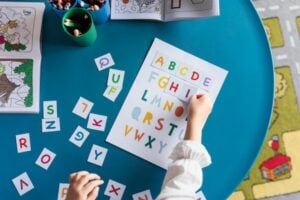Creating an IEP for a preschooler with autism focuses directly on their specific learning needs and development goals. These personalized educational plans help children build essential skills in speech, social connections, and daily activities.
Research shows that about 1 in 36 children has autism spectrum disorder, according to the CDC’s latest data from 2023. A well-designed preschool IEP brings together teachers, therapists, and parents to craft targeted strategies that support each child’s growth at this key developmental stage.
Autism and Early Intervention
Early identification of autism opens doors to targeted support that makes a real difference in a child’s development. Your preschooler receives specialized help for sensory needs and learning style through proven interventions.
Professional educators work directly with your child to build essential skills in communication and social interaction. They create custom strategies based on careful observation of how your child learns and responds.
The early years between ages 2-5 bring remarkable progress possibilities. Your child develops stronger connections through play-based activities matched to their interests. Speech therapists help unlock communication barriers while occupational therapists address sensory challenges.
Each child moves forward at their own pace with guidance from caring specialists. Simple activities like taking turns with toys or making eye contact become natural stepping stones. Clear routines and consistent positive reinforcement help your child feel secure while learning.
Parents see real progress as their child begins engaging more, showing interest in others, and finding new ways to express themselves. The supportive partnership between families and professionals creates an environment where your child can truly flourish.
Specific techniques target exactly what your child needs – from picture schedules that provide structure to sensory tools that help with focus. Regular assessments track improvements and adjust approaches for the best results.
Through dedicated early intervention, children build foundational skills that serve them well as they grow. The combination of specialized instruction and caring support helps unlock your child’s unique potential.
Key Components of a Preschool Autism IEP
An Individualized Education Program (IEP) creates specific learning paths for preschoolers with autism through targeted educational support. Every child needs unique learning strategies that match their abilities and challenges.
Core Elements of Your Child’s IEP
Communication Development
Your child’s IEP targets both verbal and non-verbal skills through proven techniques. Speech therapists guide children to express needs through words, signs, or communication devices. Regular practice sessions help kids master basic requests and responses.
Building Social Connections
Social skills bloom through guided peer interactions and emotional control activities. Teachers create structured playtime where children learn to take turns, share toys, and recognize facial expressions. Small group activities build friendship skills naturally.
Academic Foundation
Teachers introduce numbers, letters, and basic concepts through engaging activities matched to each child’s pace. Hands-on learning stations allow children to explore shapes, colors, and patterns while building pre-reading skills.
Sensory Support Strategies
Each child receives specific tools to handle different sensory experiences. Weighted vests, noise-canceling headphones, or fidget toys help students stay focused during learning activities. Quiet spaces offer breaks from overwhelming stimulation.
Positive Behavior Guidance
Clear routines and visual schedules create predictable environments where children thrive. Teachers use reward systems and gentle redirection to encourage desired behaviors. Regular parent updates track progress and maintain consistent approaches at home.
The IEP team adjusts these strategies based on your child’s responses and developmental progress. Regular meetings allow parents and teachers to fine-tune learning approaches for the best results.
Developing Meaningful and Measurable Goals
Creating effective IEP goals for preschoolers with autism requires a targeted, personal approach. Your child’s roadmap starts with specific, measurable objectives that build on their unique abilities.
Setting Clear Development Targets
Each child needs goals that match their natural learning style and pace. A skilled team observes how your child communicates, plays, and processes information to create meaningful objectives. Your input about daily routines and interests helps shape these goals.
Making Goals Work in Real Life
Goals need concrete steps your child can achieve day by day. Instead of “will improve social skills,” a better goal reads “will take turns with peers during structured play activities 3 times per session.” This gives teachers and therapists clear ways to track progress.
Key Areas for Goal Development
Communication goals focus on practical skills like requesting items or expressing feelings. Social targets involve playing near others, sharing toys, or responding to greetings. Behavior goals address specific challenges through positive strategies.
Measuring Success Step by Step
Teachers track your child’s progress through detailed notes and regular assessments. They adjust strategies based on what works best – whether it’s visual schedules, reward systems, or breaking tasks into smaller pieces.
Building on Strengths
Every goal connects to your child’s interests and natural talents. A child who loves music learns turn-taking through musical games. Another who enjoys trains practices language skills while playing with train sets.
Goals become achievable through consistent practice across settings – at school, home, and therapy sessions. Regular team meetings help adjust approaches as your child grows and develops new skills.
Strategies for Supporting Social and Communication Skills
Supporting children with autism requires specific communication strategies that work with their unique learning styles. Visual aids, social scripts, and play-based activities create effective ways to build social connections.
Your child learns best through activities that engage multiple senses at once. Simple picture cards show exactly what to say or do during social interactions. Taking turns with toys or games teaches basic conversation skills through hands-on practice.
Teachers and therapists model proper social responses step-by-step. A child learns to wave hello, make eye contact, or ask to join others at play. Regular positive feedback helps these behaviors become natural habits.
Structured playgroups give children chances to practice new skills together. A teacher guides activities like building blocks or pretend cooking, showing how to share and communicate with peers. Visual schedules help children follow the group routine.
Social stories prepare children for everyday situations through clear, illustrated explanations. Stories about taking turns on the playground or sitting quietly at circle time make expectations clear. Children refer to these stories to remember appropriate responses.
Interactive games strengthen joint attention – the ability to focus on an activity with another person. Rolling a ball back and forth or playing peek-a-boo teaches the basic rhythm of social give-and-take. These simple exchanges build foundations for more complex interactions.
Clear communication routines at home reinforce school learning. Parents model greetings, please/thank you, and taking turns during daily activities. Consistent practice across settings helps skills become automatic.
Small group activities match children with similar abilities for targeted practice. Three or four children work together on a puzzle or art project while an adult guides their interactions. This controlled setting makes social learning less overwhelming.
The key lies in breaking down social skills into small, manageable steps with lots of repetition and encouragement. Each child progresses at their own pace as they build confidence in communicating with others.
Collaborative Approach: Working With Parents and Educators
Supporting Your Child Through Parent-Teacher Teamwork
Parents and teachers create the strongest support system for children with autism by working together. Clear communication and shared strategies help your child thrive both at home and school.
Building Strong Parent-Teacher Partnerships
Regular check-ins between parents and teachers keep everyone aligned on your child’s progress. Share what works at home – from morning routines to favorite calming activities. Teachers can adapt these familiar approaches in the classroom.
Creating Consistent Support Strategies
Track behavioral techniques that work through shared notebooks or apps. Document specific situations, responses, and results. This helps both parents and teachers:
- Apply consistent responses to challenging behaviors
- Reinforce positive social interactions
- Adjust strategies based on what succeeds
Bridging Home and School Environments
Help your child transfer skills between settings through:
- Using the same visual schedules at home and school
- Practicing classroom routines during homework time
- Sharing social stories about school activities
- Maintaining similar reward systems
Parents and teachers who coordinate closely give children with autism the steady support needed for building social skills. Open dialogue and shared approaches create an environment where your child feels secure and ready to learn.
Conclusion
IEPs for preschoolers with autism provide a clear path for their educational growth and success. These personalized plans focus on specific skills, from communication to social interaction, helping children reach their full potential. Research from the CDC indicates that early intervention through structured IEPs can improve developmental outcomes in up to 85% of children with autism spectrum disorders. With consistent support and targeted strategies, each child can build the foundation they need to thrive in school and beyond.





